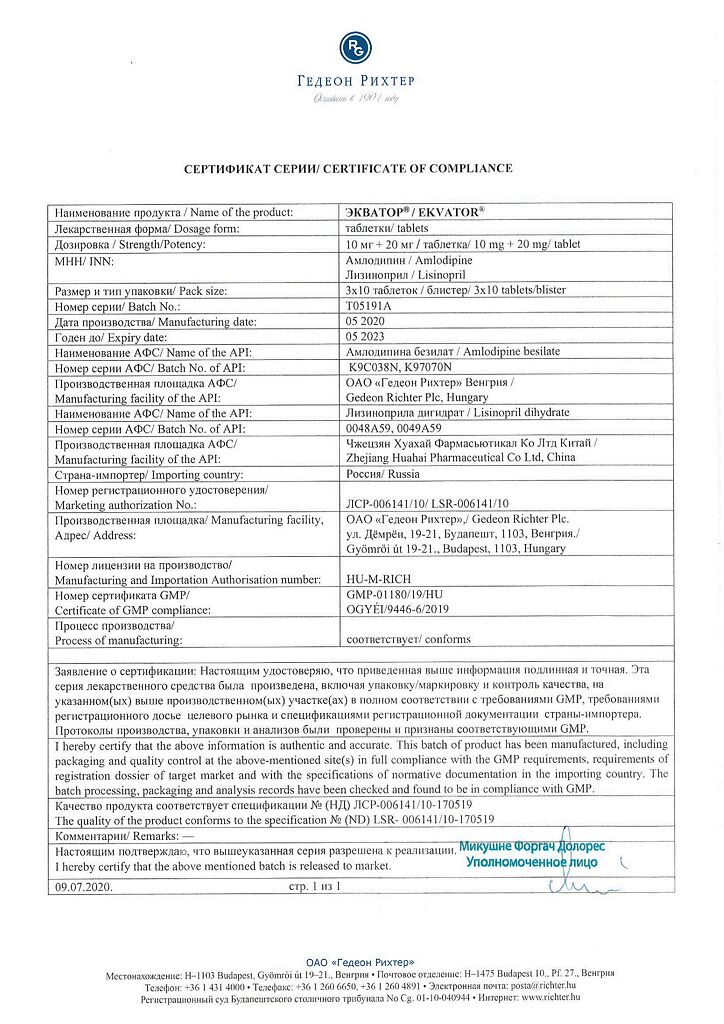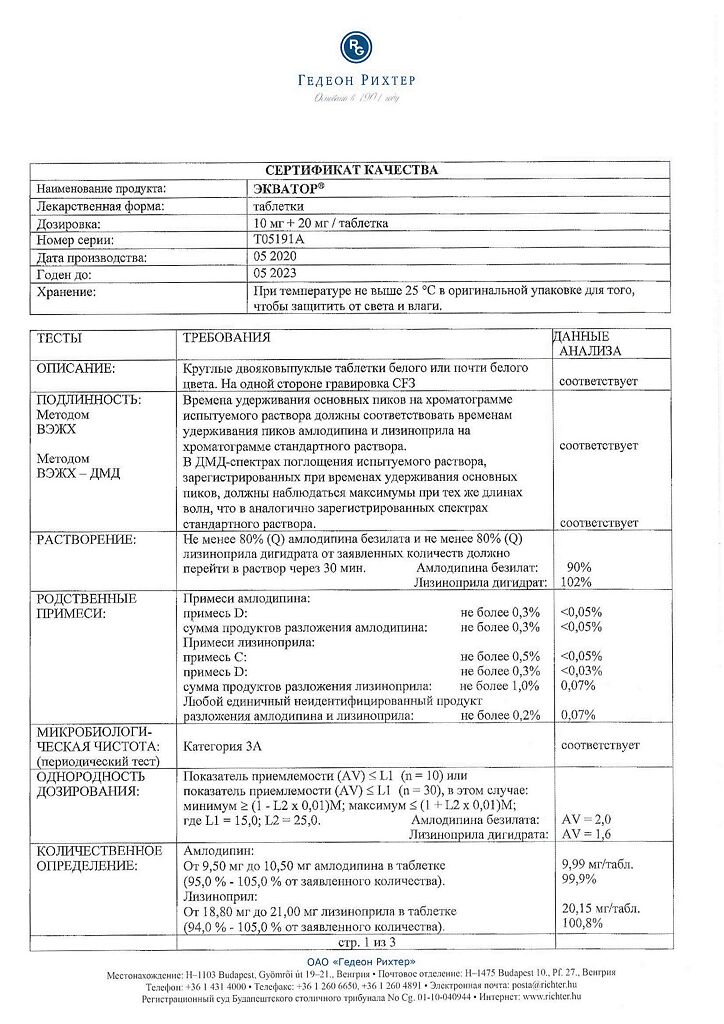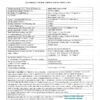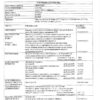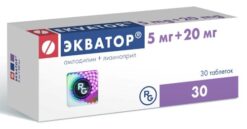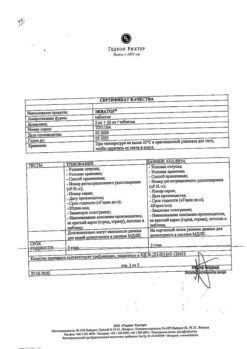No products in the cart.
Equator, tablets 10 mg+20 mg 30 pcs
€32.22 €26.85
Description
Equator is a combined antihypertensive drug containing lisinopril and amlodipine.
Lisinopril is an ACE inhibitor, reduces blood levels of angiotensin II and aldosterone while increasing levels of bradykinin, a vasodilatory mediator. Effects on tissue renin-angiotensin systems. It decreases RPS and BP, pre- and post-load, pulmonary capillary pressure, has no effect on HR, while it may increase cardiac output and increase blood flow in the kidneys. Dilates arteries more than veins. Improves blood supply to ischemic myocardium.
Long-term use promotes reduction of myocardial hypertrophy and resistive artery walls. Increases myocardial tolerance to exercise in patients with chronic heart failure. Plays a role in restoring endothelial function damaged due to hyperglycemia.
Lengthens life expectancy in chronic heart failure. Slows the progression of left ventricular dysfunction after myocardial infarction not complicated by heart failure.
Hypotensive effect is observed 1 hour after oral administration of the drug, reaching a maximum after 6 hours. The duration of action depends on the dose and is 24 hours. With long-term treatment the efficacy does not decrease. There is no withdrawal syndrome with a sharp increase in BP when the treatment is stopped abruptly.
Despite the primary effect manifested in the effect on the RAAS, it is also effective in arterial hypertension with low levels of renin.
Lisinopril decreases albuminuria not only due to BP decrease, but also due to the changes in hemodynamics of glomerular apparatus and its tissue structure. It does not affect blood sugar levels in diabetic patients and does not increase the incidence of hypoglycemia.
Amlodipine is a III generation slow calcium channel blocker, has antianginal and hypotensive effect. It prevents calcium influx into myocardial cells and, to a greater extent, into smooth muscle cells of the vascular wall. It reduces the tone of arteriolar smooth muscle, OPPS and, therefore, BP.
It has an antianginal effect by dilating the arterioles and arteries and reducing the afterload. It reduces the need for oxygen and myocardial energy expenditure, as it does not cause reflex tachycardia. Probably due to the expansion of coronary arteries and arterioles it increases the supply of oxygen to the intact (especially in vasospastic angina) and ischemic areas of the myocardium. In angina improves exercise tolerance, prevents the development of an attack of angina and the formation of ischemic ST interval, reducing the frequency of angina attacks and the need for nitroglycerin use.
It does not affect myocardial conduction and contractility.
It has a long-lasting, dose-dependent hypotensive effect. Does not reduce left ventricular ejection fraction. Reduces left ventricular hypertrophy. It has antiatherosclerotic and cardioprotective effect in CHD. Its usage along with digoxin, diuretics and ACE inhibitors does not increase the risk of death in patients with chronic heart failure (functional class III-IV according to NYHA classification).
Slow absorption, wide distribution in the body and slow excretion provides prolonged action, allowing to take the drug once/ For more than 24 hours provides significant clinically significant reduction of BP in sitting and lying position. The action develops gradually, 2-4 hours after administration and is not accompanied by arterial hypotension.
Inhibits platelet aggregation, increases glomerular filtration, has a weak natriuretic effect, in diabetic nephropathy it does not increase microalbuminuria.
It does not have adverse effects on metabolic processes, does not change the level of plasma lipids. It can be prescribed to patients with concomitant bronchial asthma, diabetes and gout.
Combining lisinopril with amlodipine in one drug prevents possible adverse effects caused by counterregulation of any of the active substances. For example, a slow calcium channel blocker, by directly dilating the arterioles, can lead to sodium and fluid retention in the body and, therefore, can activate the RAAS. ACE inhibitor blocks this process, normalizes the response to salt load.
Indications
Indications
Essential hypertension (patients for whom combination therapy is indicated).
Pharmacological effect
Pharmacological effect
Equator is a combination antihypertensive drug containing lisinopril and amlodipine.
Lisinopril is an ACE inhibitor, reduces the levels of angiotensin II and aldosterone in the blood, while simultaneously increasing the level of bradykinin, a vasodilator mediator. Affects tissue renin-angiotensin systems. Reduces OPSS and blood pressure, pre- and afterload, pressure in the pulmonary capillaries, does not affect heart rate, while it is possible to increase cardiac output and increase blood flow in the kidneys. Dilates arteries more than veins. Improves blood supply to ischemic myocardium.
With long-term use, it helps reduce hypertrophy of the myocardium and the walls of resistive arteries. Increases myocardial tolerance to physical activity in patients with chronic heart failure. Plays a role in restoring endothelial function damaged as a result of hyperglycemia.
Increases life expectancy in chronic heart failure. Slows the progression of left ventricular dysfunction after myocardial infarction not complicated by heart failure.
The hypotensive effect is observed 1 hour after taking the drug orally, reaching a maximum after 6 hours. The duration of action depends on the dose and is 24 hours. With long-term treatment, the effectiveness does not decrease. With abrupt cessation of treatment, withdrawal syndrome with a sharp increase in blood pressure does not occur.
Despite the primary effect, which manifests itself in the effect on the RAAS, it is also effective in arterial hypertension with low renin levels.
Lisinopril reduces albuminuria not only due to a decrease in blood pressure, but also as a result of changes in the hemodynamics of the glomerular apparatus and its tissue structure. Does not affect blood sugar levels in patients with diabetes and does not increase the incidence of hypoglycemia.
Amlodipine is a third-generation slow calcium channel blocker that has antianginal and hypotensive effects. Prevents the entry of calcium into myocardial cells and, to a greater extent, into smooth muscle cells of the vascular wall. Reduces the tone of smooth muscles of arterioles, peripheral vascular resistance and, consequently, blood pressure.
It has an antianginal effect by dilating arterioles and arteries and reducing afterload. Reduces the need for oxygen and energy consumption of the myocardium, because does not cause reflex tachycardia. Probably, due to the expansion of the coronary arteries and arterioles, it increases the oxygen supply to intact (especially with vasospastic angina) and ischemic areas of the myocardium. For angina pectoris, it improves exercise tolerance, prevents the development of an angina attack and the formation of an ischemic ST interval, reducing the frequency of angina attacks and the need for the use of nitroglycerin.
Does not affect the conductivity and contractility of the myocardium.
It has a long-term, dose-dependent hypotensive effect. Does not reduce left ventricular ejection fraction. Reduces left ventricular hypertrophy. It has an antiatherosclerotic and cardioprotective effect in ischemic heart disease. Use during therapy with digoxin, diuretics and ACE inhibitors does not increase the risk of death in patients with chronic heart failure (III-IV functional class according to the NYHA classification).
Slow absorption, wide distribution in the body and slow excretion ensure a long-lasting effect, allowing you to take the drug 1 time. For more than 24 hours, it provides a significant reduction in blood pressure in the sitting and lying position from a clinical point of view. The effect develops gradually, 2-4 hours after administration and is not accompanied by arterial hypotension.
Inhibits platelet aggregation, enhances glomerular filtration, has a weak natriuretic effect, and does not increase microalbuminuria in diabetic nephropathy.
Does not have a negative effect on metabolic processes, does not change the level of plasma lipids. Can be prescribed to patients with concomitant bronchial asthma, diabetes mellitus and gout.
The combination of lisinopril with amlodipine in one drug helps prevent the development of possible undesirable effects caused by counterregulation of any of the active substances. Thus, a blocker of slow calcium channels, directly dilating arterioles, can lead to sodium and fluid retention in the body and, therefore, can activate the RAAS. An ACE inhibitor blocks this process and normalizes reactions to salt load.
Special instructions
Special instructions
– Arterial hypotension
A pronounced decrease in blood pressure with the development of clinical symptoms can be observed in patients with reduced blood volume and/or sodium content due to the use of diuretics, fluid loss, or for other reasons, for example, profuse sweating, prolonged vomiting and/or diarrhea. In case of arterial hypotension, the patient should be laid down and fluid loss should be replaced (iv infusion of 0.9% sodium chloride solution) if necessary.
It is preferable that restoration of fluid and/or sodium loss be carried out before starting Equator therapy. It is necessary to monitor blood pressure after taking the initial dose. This is especially true for patients with coronary artery disease or cerebrovascular diseases, when a pronounced decrease in blood pressure can lead to myocardial infarction or stroke.
– Aortic and mitral stenosis
Like all vasodilators, Equator® should be prescribed with caution to patients with left ventricular outflow tract obstruction and mitral valve stenosis.
– Renal dysfunction
In some patients with arterial hypertension without significant manifestations of renovascular diseases, an increase in creatinine and urea in the blood serum was observed, in most cases minimal or transient, more pronounced when taking ACE inhibitors and a diuretic simultaneously. This is most common in patients with a history of kidney disease.
– Angioedema
Angioedema of the face, extremities, lips, tongue, vocal folds and/or larynx has been reported in patients taking an ACE inhibitor, including lisinopril. In these cases, taking Equator should be stopped immediately and the patient should be closely monitored until symptoms disappear completely.
Swelling of the face, lips and limbs usually goes away on its own, however, antihistamines should be used to reduce the severity of symptoms.
Angioedema, accompanied by swelling of the larynx, can be fatal. If swelling of the tongue, pharynx or larynx is detected, which is the cause of airway obstruction, emergency measures must be immediately initiated. Appropriate measures include: subcutaneous administration of 0.3-0.5 mg or slow intravenous administration of 0.1 mg of a 0.1% solution of epinephrine (adrenaline), followed by intravenous administration of corticosteroids and antihistamines and simultaneous monitoring of vital functions.
Angioedema of the intestine has rarely occurred in patients taking ACE inhibitors. These patients complained of abdominal pain (with or without nausea and vomiting); in some cases, no previous facial edema was observed and C-1 esterase activity was within normal limits. Angioedema of the intestine was diagnosed according to computed tomography of the gastrointestinal tract, or after ultrasound examination, or during surgery, the symptoms disappeared after stopping the ACE inhibitor. When conducting a differential diagnosis of abdominal pain in patients taking ACE inhibitors, angioedema of the intestine should also be taken into account.
– Anaphylactic reactions in patients on hemodialysis
Cases of anaphylactic shock have been reported in patients undergoing polyacrylonitrile membrane hemodialysis (eg, AN69®) and concomitantly receiving ACE inhibitors, and this combination should be avoided. Patients are advised to use either a different type of dialysis membrane or a different class of antihypertensive drug.
Anaphylactic reactions in patients during LDL apheresis
Rarely, life-threatening anaphylactic reactions have developed in patients receiving ACE inhibitors during LDL dextran sulfate apheresis. Such reactions were prevented by discontinuation of ACE inhibitors before each apheresis procedure.
– Desensitization with wasp or bee venom
Sometimes patients taking ACE inhibitors developed anaphylactic reactions when desensitized by hymenoptera venom (for example, wasps or bees). Such life-threatening situations can be avoided with timely discontinuation of ACE inhibitors.
– Hepatotoxicity
In rare cases, the use of ACE inhibitors was accompanied by a syndrome that began with cholestatic jaundice or hepatitis and developed into fulminant liver necrosis and, in several cases, led to death. The mechanism of this syndrome is unclear. In patients receiving Equator®, if jaundice develops or the activity of liver enzymes increases, Equator® should be discontinued with subsequent monitoring of their condition.
– Liver failure
In patients with impaired liver function, T1/2 of amlodipine is prolonged. At the moment, recommendations on the dosage regimen have not been developed, so Equator® should be prescribed with caution, having previously assessed the expected benefits and potential risks of treatment.
– Hematological toxicity
In rare cases, neutropenia, agranulocytosis, thrombocytopenia and anemia have been reported in patients receiving ACE inhibitors. In patients with normal renal function and in the absence of other aggravating factors, neutropenia is rare. Neutropenia and agranulocytosis are reversible and disappear after discontinuation of the ACE inhibitor.
Equator® should be used with extreme caution in patients with collagen vascular disease, during immunosuppressive therapy, during treatment with allopurinol or procainamide, or a combination of these aggravating factors, especially in the presence of pre-existing renal impairment. Some of these patients developed serious infectious diseases, which in several cases did not respond to antibiotic therapy.
During treatment with Equator®, it is recommended to periodically monitor the level of leukocytes in such patients, and also warn them about the need to report the first signs of an infectious disease.
– Cough
Cough has been frequently reported during the use of ACE inhibitors. As a rule, the cough is non-productive, constant and stopped after discontinuation of the drug. In the differential diagnosis of cough, cough caused by the use of ACE inhibitors should also be taken into account.
– Surgery/general anesthesia
In patients undergoing major surgery or during general anesthesia with drugs that lead to hypotension, lisinopril may block the formation of angiotensin II after compensatory renin release. If arterial hypotension develops, probably as a result of the above mechanism, correction can be made by increasing the volume of blood volume.
– Elderly patients
Elderly patients with impaired renal function should undergo a dose adjustment of Equator®.
– Hyperkalemia
Increases in serum potassium levels have been observed in some patients receiving ACE inhibitors. Patients at risk for the development of hyperkalemia include patients with renal failure, diabetes mellitus, acute heart failure, dehydration, metabolic acidosis, or while taking potassium-sparing diuretics, potassium supplements, potassium-containing salt substitutes, or any other medications that increase serum potassium levels (for example, heparin).
If necessary, simultaneous use with the above drugs should monitor the concentration of potassium in the blood serum.
Patients with low body weight, patients of short stature and patients with severe liver dysfunction may require a dose reduction.
Equator® does not have any adverse effect on metabolism and blood plasma lipids and can be used in the treatment of patients with bronchial asthma, diabetes mellitus and gout.
During treatment, weight control and dental supervision are necessary (to prevent pain, bleeding and gum hyperplasia).
– Impact on the ability to drive vehicles and operate machinery
Equator® may affect the ability to drive vehicles and operate complex machinery. Transient arterial hypotension and dizziness may occur mainly at the beginning of treatment. Therefore, at the beginning of treatment, patients are advised to avoid driving vehicles, operating machinery, and performing other work that requires concentration.
Active ingredient
Active ingredient
Amlodipine, Lisinopril
Composition
Composition
1 table contains amlodipine 10 mg and lisinopril 20 mg.
Pregnancy
Pregnancy
Equator is contraindicated during pregnancy.
Treatment should be stopped as soon as possible if pregnancy is detected.
Taking lisinopril in the second and third trimesters of pregnancy can cause damage and death to the fetus as a result of the effect on its kidneys (hypotension, renal failure, hyperkalemia).
The use of Equator can cause a decrease in the amount of amniotic fluid, lead to deformation of the skull and face, impaired development of the limbs, pulmonary hypoplasia and fetal death. There are no data on similar or other effects in earlier pregnancy.
Taking the drug during lactation is contraindicated due to the excretion of amlodipine in breast milk. There are no data indicating that lisinopril passes into breast milk.
Contraindications
Contraindications
hypersensitivity to any of the components of Equator or to other dihydropyridine derivatives;
history of angioedema, incl. caused by the use of other ACE inhibitors, hereditary or idiopathic;
hemodynamically significant aortic or mitral valve stenosis or hypertrophic cardiomyopathy;
severe arterial hypotension, cardiogenic shock;
pregnancy;
breastfeeding period;
age under 18 years (due to the lack of data on the effectiveness and safety of Equator in this age group).
Side Effects
Side Effects
The adverse reactions encountered are usually mild and transient; discontinuation of treatment is required in rare cases.
Side effects caused by the combination drug do not occur more often than when each component is taken separately. The most common: headache (8%), dry cough (5%) and dizziness (3%). Possible: weakness, diarrhea, nausea, vomiting, orthostatic hypotension, skin itching, skin rash, swelling of the ankles, redness of the facial skin, chest pain, arthralgia (1-3%). The incidence of other side effects is less than 1%.
With increased sensitivity, angioedema of the face, limbs, lips, tongue, epiglottis and larynx may develop (0.1%). In such cases, treatment should be stopped immediately and the patient observed until all symptoms disappear completely.
From laboratory parameters: hyperkalemia, increased levels of creatinine, urea nitrogen, liver enzyme activity and blood bilirubin, especially in kidney disease, diabetes mellitus and renovascular hypertension.
From the hematopoietic organs: leukopenia, neutropenia, agranulocytosis (exposure to an ACE inhibitor), thrombocytopenia, erythrocytopenia; with long-term treatment, a slight decrease in the concentration of hemoglobin and hematocrit is possible.
Other rare adverse reactions:
From the cardiovascular system: arrhythmias, increased heart rate, tachycardia, probably as a result of an excessive decrease in blood pressure in patients at high risk of myocardial infarction, cerebrovascular stroke.
From the digestive tract: impaired intestinal function, dry mouth, abdominal pain, pancreatitis, hepatocellular or cholestatic jaundice, hepatitis, gingival hyperplasia, loss of appetite.
From the skin: urticaria, increased sweating, itching, alopecia.
From the genitourinary system: impaired renal function, frequent urination, oliguria, anuria, acute renal failure, uremia, proteinuria, impotence.
From the immune system: syndrome with the appearance of antinuclear antibodies, accelerated ESR and arthralgia; myalgia; erythema multiforme; fever.
From the central nervous system: increased drowsiness, muscle fasciculation of the limbs and lips, asthenia, mood lability, confusion.
Interaction
Interaction
Lisinopril
Potassium-sparing diuretics (eg, spironolactone, amiloride, and triamterene), potassium supplements, potassium-containing salt substitutes, and other medications that can increase serum potassium levels (eg, heparin) may cause hyperkalemia when combined with ACE inhibitors, especially in patients with renal insufficiency or a history of other renal disease. When prescribing a drug that affects potassium concentrations concomitantly with lisinopril, serum potassium concentrations should be monitored.
Therefore, simultaneous administration should be carefully justified and carried out with extreme caution and regular monitoring of both serum potassium levels and renal function. Potassium-sparing diuretics can be taken together with the drug Equator only under medical supervision. If a diuretic is prescribed to a patient receiving Equator, the hypotensive effect is usually enhanced. Therefore, it is necessary to take Equator® with extreme caution in combination with diuretics. Lisinopril softens the kaliuretic effect of diuretics. With the simultaneous use of other antihypertensive drugs, the hypotensive effect of the drug Equator may be enhanced.
When taken simultaneously with nitroglycerin, other nitrates or vasodilators, a more pronounced decrease in blood pressure is possible.
When used simultaneously with ACE inhibitors, tricyclic antidepressants/antipsychotics, general anesthesia, opioid analgesics: a more pronounced decrease in blood pressure is possible.
Ethanol enhances the hypotensive effect of the drug. Allopurinol, procainamide, cytostatics or immunosuppressants (systemic corticosteroids) may increase the risk of developing leukopenia when used simultaneously with ACE inhibitors.
Aitacids and cholestyramine, when taken simultaneously with ACE inhibitors, reduce the bioavailability of the latter.
Sympathomimetics may reduce the hypotensive effect of ACE inhibitors; it is necessary to carefully monitor the achievement of the desired effect. When taking ACE inhibitors and hypoglycemic drugs (insulins and oral hypoglycemic agents) simultaneously, the likelihood of a decrease in blood glucose concentrations and the risk of hypoglycemia may increase. This phenomenon is most often observed during the first week of combination treatment and in patients with renal failure. With long-term use of NSAIDs, including acetylsalicylic acid in high doses, the effectiveness of ACE inhibitors may decrease.
The additive effect when taking NSAIDs and ACE inhibitors is manifested by an increase in serum potassium levels and can lead to a deterioration in renal function. These effects are usually reversible. Very rarely, acute renal failure may develop, especially in elderly patients and patients in a state of dehydration.
Lithium excretion may be slowed during concomitant use with ACE inhibitors and therefore serum lithium concentrations should be monitored during this period. When used together with lithium preparations, it is possible to increase the manifestation of their neurotoxicity (nausea, vomiting, diarrhea, ataxia, tremor, tinnitus).
With the simultaneous use of ACE inhibitors and gold drugs (sodium aurothiomalate) intravenously, a symptom complex has been described, including facial flushing, nausea, vomiting and arterial hypotension.
Amlodipine
Studies in elderly patients have shown that diltiazem suppresses the metabolism of amlodipine, probably due to inhibition of the CYP3A4 isoenzyme (plasma concentration increases by almost 50% and the effect of amlodipine is increased). We cannot exclude the possibility that stronger inhibitors of the CYP3A4 isoenzyme (i.e. ketoconazole, itraconazole, ritonavir) are capable of increasing the plasma concentration of amlodipine to a greater extent than diltiazem.
Concomitant use should be done with caution.
When used simultaneously with inducers of the CYP3A4 isoenzyme – with antiepileptic drugs (for example, carbamazepshyum, phenobarbital, phenytoin, fosphenytoin, primidone), rifampicin, herbal preparations containing St. John’s wort – a decrease in the concentration of amlodipine in the blood plasma is possible. Clinical monitoring with possible dose adjustment of amlodipine is indicated during treatment with inducers of the CYP3A4 isoenzyme and after their discontinuation. Concomitant use should be done with caution.
As monotherapy, amlodipine was well combined with thiazide and loop diuretics, general anesthesia, beta-blockers, ACE inhibitors, long-acting nitrates, sublingual nitroglycerin, digoxin, warfarin, atorvastatin, sildenafil, antacids (aluminum hydroxide, magnesium hydroxide), simethicone, cimetidine, NSAIDs, antibiotics and oral hypoglycemic drugs.
Amlodipine does not have a significant effect on the pharmacokinetics of ethanol. Calcium supplements may reduce the effect of slow calcium channel blockers. Amlodipine does not cause significant changes in the pharmacokinetics of cyclosporine. It is possible to reduce the hypotensive effect of Equator when taken simultaneously with estrogens and adrenergic stimulants. When used simultaneously with Equator®, procainamide, quinidine and other drugs that prolong the QT interval can contribute to its significant prolongation.
Overdose
Overdose
Symptoms: excessive peripheral vasodilation with a pronounced decrease in blood pressure, acute vascular insufficiency, water and electrolyte imbalance, renal failure, hyperventilation, tachycardia, bradycardia, dizziness, anxiety, cough.
Treatment: symptomatic therapy, monitoring of cardiac activity, blood pressure, diuresis and water-electrolyte balance, and, if necessary, its correction. With a pronounced decrease in blood pressure, the patient is placed in a lying position and the lower limbs are raised; If the therapeutic response to intravenous fluid replacement is unsatisfactory, dopamine may be required. To stop the action of amlodipine, calcium gluconate can be administered intravenously.
If necessary, intravenous administration of angiotensin II. Due to the slow absorption of amlodipine, in some cases the stomach is washed out and activated charcoal is used. Lisinopril is eliminated by hemodialysis; the strong degree of binding to blood proteins makes amlodipine dialysis ineffective.
Storage conditions
Storage conditions
In a place protected from light, at a temperature not exceeding 30 °C
Shelf life
Shelf life
2 years
Manufacturer
Manufacturer
Gedeon Richter, Hungary
Additional information
| Shelf life | 2 years |
|---|---|
| Conditions of storage | In a light-protected place, at a temperature not exceeding 30 °C |
| Manufacturer | Gedeon Richter Rus, Russia |
| Medication form | pills |
| Brand | Gedeon Richter Rus |
Other forms…
Related products
Buy Equator, tablets 10 mg+20 mg 30 pcs with delivery to USA, UK, Europe and over 120 other countries.


